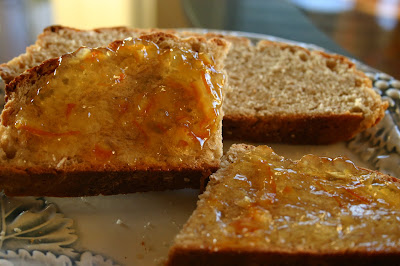
 I have a large head. No, that's not a metaphor. I really mean it, my head is large. Not Elephant-Man-large, but on the larger end of the cranium circumference continuum. Bigger head = bigger brain? I'd like to think so, but buy into that twist of neuroanatomic reality and pretty soon you are sliding down the slippery slope toward phrenology. A big head means that buying hats can be difficult, as can finding wigs that fit comfortably...for Halloween. I
I have a large head. No, that's not a metaphor. I really mean it, my head is large. Not Elephant-Man-large, but on the larger end of the cranium circumference continuum. Bigger head = bigger brain? I'd like to think so, but buy into that twist of neuroanatomic reality and pretty soon you are sliding down the slippery slope toward phrenology. A big head means that buying hats can be difficult, as can finding wigs that fit comfortably...for Halloween. I But I have reason to question family lore, particularly when it comes to ancestral heritage. An oft-told, but suspiciously abbreviated, tale from my childhood included a pair of Norwegian brothers who came over on the boat and settled in upstate New York to make their fame and/or fortune, reproduce heartily and, fastforward, here I am...large head and all. Plausible. So I went with it...proud of my Norwegian background I chose the language of my forefathers as my foreign language in college (3 semesters worth), read Norwegian folktales, and tried to insert "Uff da" into my daily lexicon. I was getting there...at the height of my Norwegian-ness I was even dreaming in the language of my stoic Nordic ancestors.
 Then this noble Viking house-of-cards folded with one quick Germanic puff of wind. My sister met a stranger who shared our Norwegian surname. An avid family arborist, this genetically-linked stranger had done her homework. Within minutes she had erased the Norwegian brothers from our past, replacing them with German(!) brothers, one who settled in hardscrabble upstate New York, the other continuing his journey across the plains and mountains and settling in California, the land of plenty. This mysterious German stranger had facts, names, and dates...the pitiful Norwegians didn't stand a chance. I traded dreams of hiking the geothermal hills of Iceland (a Norwegian version of a spa treatment, I suppose) for a trip to the motherland to drink gallons of beer. Uff da, indeed!
Then this noble Viking house-of-cards folded with one quick Germanic puff of wind. My sister met a stranger who shared our Norwegian surname. An avid family arborist, this genetically-linked stranger had done her homework. Within minutes she had erased the Norwegian brothers from our past, replacing them with German(!) brothers, one who settled in hardscrabble upstate New York, the other continuing his journey across the plains and mountains and settling in California, the land of plenty. This mysterious German stranger had facts, names, and dates...the pitiful Norwegians didn't stand a chance. I traded dreams of hiking the geothermal hills of Iceland (a Norwegian version of a spa treatment, I suppose) for a trip to the motherland to drink gallons of beer. Uff da, indeed!No bagpipe-bleating stranger has yet to wander in from the fog to weave a plaid-ridden tale of kilt-wearing Scottish barbarianism which could dissuade me of my Irishness. I am (part) Irish; I have proof - just measure my head! So, for the time-being, I offer this oven-bourne tradition from my maternal homeland, an authentic Irish Soda Bread.
The fresh-off-the-plane Irishmen who taught me this recipe were quick to point out that Ireland does not have a history filled with wealth and riches. Soda Bread was peasantfare, and a quick study of the traditional ingredients is a lesson in poverty/wealth and nutrition. Refined white flour was saved for the upperclasses, the peasants were left with wholegrain flours. Filler was needed, so a handful of whole, cracked grain makes the bread go that much farther. Butter was a product to be sold, not to be eaten by a dairyman's family, so very little fat is included in this recipe. And what is buttermilk but a byproduct from buttermaking...using whole milk or, god forbid, cream in a bread recipe would be like taking money and eating it. Fruit or spices?...forget it, they were luxuries saved for celebrations, not for this basic, daily bread. Of course, knowing what we now know about health and nutrition, we realize that if the Irish peasantclass hadn't been starving, they would have been very healthy.
Irish Soda Bread
Yield: 2 loaves
(Pardon the odd measurements, this is scaled down from a much larger batch)
AP Flour..........................8.2 oz
Whole Wheat Pastry Flour.....9.5 oz
Oats/Rolled Spelt...............1.4 oz
Whole Wheat Flour.............4 oz
Salt................................0.3 oz
Baking Soda......................0.5 oz
Sugar..............................0.5 oz
Butter.............................2 oz
Buttermilk........................20.5 oz
1. Mix all the dry ingredients. Cut the butter into the dry until well incorporated.
2. Add the buttermilk and beat thoroughly.
3. Dust work surface with whole wheat flour, and turn the dough out onto it. Divide the dough in half, form rounds, place on parchment/Silpat lined baking sheet. Dust tops lightly with whole wheat flour. Let rest 20 minutes.
4. Preheat oven to 500. Place the loaves in the oven and immediately lower temperature to 480. Bake 30-35 minutes.









